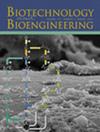3D Printable Self-Healing Mineralized Hydrogels Loaded With Diclofenac Sodium: In Vitro and In Vivo Assessment
IF 3.5
2区 生物学
Q2 BIOTECHNOLOGY & APPLIED MICROBIOLOGY
引用次数: 0
Abstract
The use of self-healing mineralized hydrogels in 3D printing has demonstrated significant advantages, including enhanced printing accuracy and the ability to maintain high shape fidelity throughout the printing process. After conducting an initial optimization study, we incorporated our self-healing mineralized hydrogel into semi-solid extrusion-based 3D printing to print diclofenac-loaded oral films. The dependence of the print speed on the nature of the material was established by varying the print speed. The process of optimizing the print speed was conducted using a blank hydrogel, which involved analyzing specific parameters, such as printing accuracy and the percentage of pore area under sizing. The results demonstrated that 2 mm/sec print speed showed a higher printing accuracy of 98.13% and pore area under-sizing value of 41.31%. Interestingly, the viscosity of the hydrogel increased from 5.30 to 133 PaS upon addition of the drug. The percentage pore area under sizing also decreased from 41.31% to 11.48% as the drug loading was increased from 0% to 3% w/w. The in vitro drug release study demonstrated that the 3% w/w diclofenac sodium-loaded oral films printed at 2 mm/sec exhibited a faster release profile. Furthermore, considerable bioavailability of diclofenac sodium (DS) was achieved from the 3D-printed oral films during the in vivo study. These results can be effectively used to develop a drug delivery system that can release medications accurately and consistently, either in a targeted area or systemically.

求助全文
约1分钟内获得全文
求助全文
来源期刊

Biotechnology and Bioengineering
工程技术-生物工程与应用微生物
CiteScore
7.90
自引率
5.30%
发文量
280
审稿时长
2.1 months
期刊介绍:
Biotechnology & Bioengineering publishes Perspectives, Articles, Reviews, Mini-Reviews, and Communications to the Editor that embrace all aspects of biotechnology. These include:
-Enzyme systems and their applications, including enzyme reactors, purification, and applied aspects of protein engineering
-Animal-cell biotechnology, including media development
-Applied aspects of cellular physiology, metabolism, and energetics
-Biocatalysis and applied enzymology, including enzyme reactors, protein engineering, and nanobiotechnology
-Biothermodynamics
-Biofuels, including biomass and renewable resource engineering
-Biomaterials, including delivery systems and materials for tissue engineering
-Bioprocess engineering, including kinetics and modeling of biological systems, transport phenomena in bioreactors, bioreactor design, monitoring, and control
-Biosensors and instrumentation
-Computational and systems biology, including bioinformatics and genomic/proteomic studies
-Environmental biotechnology, including biofilms, algal systems, and bioremediation
-Metabolic and cellular engineering
-Plant-cell biotechnology
-Spectroscopic and other analytical techniques for biotechnological applications
-Synthetic biology
-Tissue engineering, stem-cell bioengineering, regenerative medicine, gene therapy and delivery systems
The editors will consider papers for publication based on novelty, their immediate or future impact on biotechnological processes, and their contribution to the advancement of biochemical engineering science. Submission of papers dealing with routine aspects of bioprocessing, description of established equipment, and routine applications of established methodologies (e.g., control strategies, modeling, experimental methods) is discouraged. Theoretical papers will be judged based on the novelty of the approach and their potential impact, or on their novel capability to predict and elucidate experimental observations.
 求助内容:
求助内容: 应助结果提醒方式:
应助结果提醒方式:


